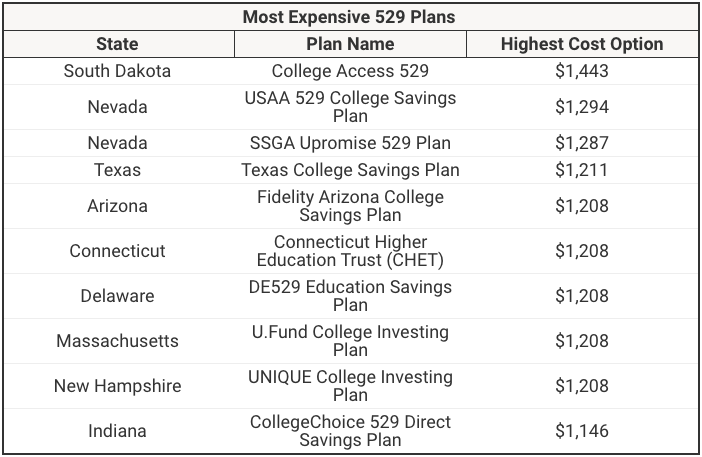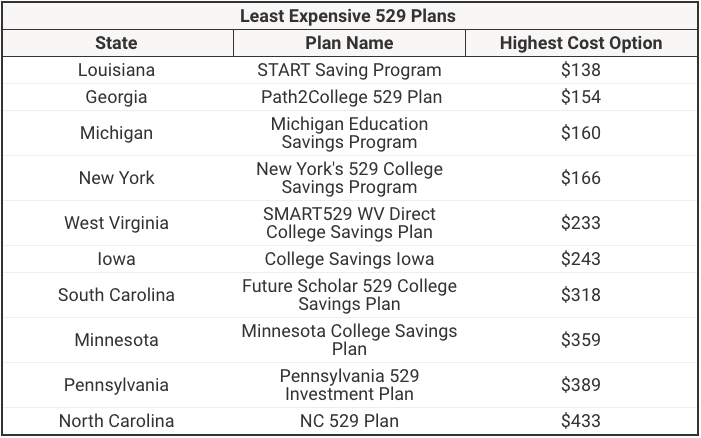
Source: The College Investor
When comparing 529 plans, you need to both look at performance and fees.
Two researchers at the University of Kansas School of Business have identified problems in how some states manage their 529 college savings plans. They suggest that these problems are caused by conflicts of interest, inadequate oversight, and a lack of investment sophistication by the state sponsors.
According to the College Savings Plan Network, a total of $508 billion is invested in 16.8 million 529 college savings plans as of June 30, 2024.
The result is that consumers who use 529 plans in certain states could be paying excess fees (as a result of these conflicts of interest), which lower their investment returns over time. If able to make a choice, consumers should opt for the lowest plan fees possible to maximize returns.
You can find your state's plan and see the fees in our 529 Plan Guide By State.
Characteristics of 529 Plan Fees
Justin Balthrop and Gjergji Cici of the University of Kansas analyzed 5,339 unique investment options across 86 state 529 college savings plans for their paper, Conflicting Incentives in the Management of 529 Plans.
Two-thirds of the 529 plans are direct-sold and one-third are advisor-sold. Only 10% of the plans are managed in-house, with the rest outsourced to external program managers. A third have revenue-sharing agreements with the underlying mutual funds.
About half of the total fees from 529 plans go to the state, the program managers, and various intermediaries.
The administrative asset-based fees for 529 plans are five times greater than the similar fees for managing a retirement plan.
The average 529 plan fees include the following:
- State Fees: 0.04%, but can be as high as 0.26%
- Program Manager Fees: 0.16%, but can be as high as 1.15%
- Distribution Fees: 0.23%, but can be as high as 1.10%
- Underlying Fund Fees: 0.38%, but can be as high as 1.29%
The overall expense ratio – the sum of all asset-based fees – averages 0.81% with a standard deviation of 0.53%. The expense ratio can be as high as 2.49%.
Given that the average return on investment for a 529 plan is about 6% based on historical performance data, some states and program managers are extracting a significant portion of investor returns for their own benefit.
In some cases, families would be better off saving in taxable accounts.
States With The Highest 529 Plan Fees
According to the most recent Saving For College 529 Plan Fee Study, here are the states with the highest fees. This study looks at the 10-years costs of a $10,000 investment for direct-sold plans. It's important to note that advisor-sold plans can have much higher fees.
Comparing the most expensive plan option to the least expensive option, South Dakota College Access 529 charges over 10x the fees of the Lousiana START Savings Program.
The 10 most expensive 529 plans in the United States all charge almost 3x the of fees of the 10 least expensive plans in the United States.
Here are the 10 most expensive 529 plans in the United States (remember, each state can, and typically does, have multiple plan options):

Analysis of the most expensive 529 plans by state. Source: The College Investor
You can compare the above states and plans with the options below. We're highlighting the HIGHEST cost option in the state. Louisiana does offer a plan with $0 costs, which is a fixed income plan managed directly by the state treasurer, but this plan is only open to in-state residents.

Analysis of the least expensive 529 plans by state. Source: The College Investor
Tradeoff between State Revenue and Program Quality
Some states charge higher fees than other states, but this generally does not yield an improvement in program quality. In fact, quite the opposite.
The 529 plans in states that extract more revenue from the 529 plans offer more limited investment options that charge higher fees and provide inferior net performance. The increase in the underlying fund fees is about a quarter of average mutual fund fees.
The higher-cost 529 plans offer fewer investment options and are less likely to offer low-cost index funds. These states also do not provide additional or better state income tax breaks.
The University of Kansas researchers found that investment options from plans where states extract the most revenue have an average underlying fund expense ratio of 0.506%, while investment options from states that extract the least revenue have an average underlying expense ratio of 0.219%. Thus, when a state extracts more revenue from the state’s 529 plan, the expense ratio is more than twice as high (2.3x higher).
The University of Kansas researchers also used Sharpe Ratios calculated by Morningstar for all the 529 plans, showing that investors in these higher-cost 529 plans experience worse performance.
A Sharpe Ratio is a risk-adjusted return on investment. It is the 529 plan’s return on investment minus the risk-free rate of return and divided by the standard deviation of the excess return. A higher Sharpe Ratio is better.
The 529 plans from states that extract more revenue from the 529 plans have a lower Sharpe Ratio than 529 plans from states that extract less revenue, a sign that the investment plan performance, net of fees, is inferior. The Sharpe Ratios in the 529 plans in the high revenue-extraction states are 20% lower than the Sharpe Ratios in the states that extract the least revenue from the 529 plans.
Related: Best 529 Plans Based On Performance
Conflicts of Interest
Since 529 plans generate revenue for the states and program managers, there is potential for conflicts of interest.
Incentives for the state are not necessarily aligned with the best interests of plan participants.
States get higher fees in exchange for providing program managers with more flexibility to extract more revenue, directly and indirectly, from plan participants.
529 plans often include investment options from the program manager’s own mutual funds and from investment firms with which the program manager has revenue-sharing agreements.
529 plans with revenue-share agreements have underlying fund fees and total expense ratios that are 0.08% and 0.18% higher than other 529 plans.
Some examples the report highlighted were plans using excess fees to fund other state initiatives. Or there being a dis-incentive to negotiate better fees for investors since states enjoy the excess revenues. In the most egregious form, 529 plan fees may be used to fund advertising campaigns that some critics have called political campaigning, rather than investor education.
Lax Oversight
There is very little effective oversight over the management of 529 plans.
529 plans are exempt from the Investment Company Act of 1940 and Securities Act of 1933. They are not required to register with the Securities and Exchange Commission (SEC), so the SEC is not a source of investor protection. SEC rules concerning investment disclosure do not apply to the 529 plans.
529 plans are not subject to a fiduciary standard. However, SEC regulations do require investment advisors, such as those that recommend advisor-sold 529 plans, to disclose conflicts of interest and consider costs when recommending products. The SEC’s Regulation Best Interest (Reg BI) is not quite a fiduciary standard, just a suitability standard. It does not apply to the 529 plans themselves, just the investment advisors.
The states provide some oversight by appointing advisory boards. However, the politically-appointed advisory boards may lack the financial sophistication needed to align the 529 plan with the best interests of investors.
Program managers often provide more fee revenue to the states that have weaker oversight.
Inadequate disclosures make it harder for investors to make informed decisions. There aren’t any uniform disclosure practices that are standardized across all 529 plans.
States that charge higher fees, which affects the net return on investment, do not provide better benefits for investors.
The states provide some oversight by appointing advisory boards. However, the politically-appointed advisory boards often lack the financial sophistication needed to align the 529 plan with the best interests of investors.
States that charge higher fees, which affects the net , do not provide better benefits for investors.
Program managers often provide more fee revenue to the states that have weaker oversight.
Inadequate disclosures make it harder for investors to make informed decisions. There aren’t any uniform disclosure practices that are standardized across all 529 plans.
Comparing 529 Plans: Tips for Investors
Minimizing costs is the key to maximizing net returns.
Higher fees are not associated with a better net performance after subtracting the fees from investment returns. The investment options do not necessarily provide better returns on investment. Even when they do, the increased returns are not enough to compensate for the higher fees.
So, investors should choose the state 529 plans with the lowest fees.
There is often a tradeoff between low fees in an out-of-state 529 plan and state income tax breaks for contributions to the state’s own 529 plan. There is an inflection point between choosing low fees and state income tax breaks when the child enters high school. Keep the following in mind, if choosing a 529 plan in the future:
- When the child is young, the families should focus on 529 plans that have lower fees.
- When the child enters high school, new contributions should be directed to that state’s 529 plan if the state offers a state income tax break on contributions to the state’s 529 plan.
Low fees apply to the entire 529 plan balance, while the state income tax break applies only to each year’s new contributions.
Morningstar.com and Savingforcollege.com provide ratings of 529 plans that consider the net return on investment after subtracting the fees. Savingforcollege.com also publishes a that evaluates the impact of the range of fees charges by each direct-sold 529 plan’s investment options.
For a better understanding of contributing to a 529 plan in your state and what fees are involved, check out our complete 529 guide.

Mark Kantrowitz is an expert on student financial aid, scholarships, 529 plans, and student loans. He has been quoted in more than 10,000 newspaper and magazine articles about college admissions and financial aid. Mark has written for the New York Times, Wall Street Journal, Washington Post, Reuters, USA Today, MarketWatch, Money Magazine, Forbes, Newsweek, and Time. You can find his work on Student Aid Policy here.
Mark is the author of five bestselling books about scholarships and financial aid and holds seven patents. Mark serves on the editorial board of the Journal of Student Financial Aid, the editorial advisory board of Bottom Line/Personal, and is a member of the board of trustees of the Center for Excellence in Education. He previously served as a member of the board of directors of the National Scholarship Providers Association. Mark has two Bachelor’s degrees in mathematics and philosophy from the Massachusetts Institute of Technology (MIT) and a Master’s degree in computer science from Carnegie Mellon University (CMU).
Editor: Robert Farrington Reviewed by: Colin Graves